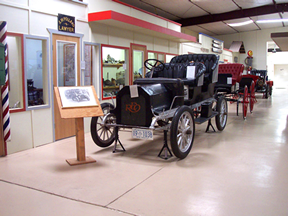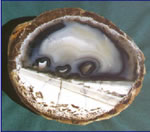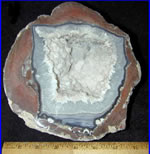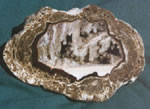Deming Luna Mimbres Museum Circa 2011
This was the home of the Deming Luna Mimbres Museum for a number of years. This archived reference has been restored as reading material for Diane Rebus' course on indigenous art. She comes to the university from the infamous cyber agency Spectropolis where she is known for the art direction on the advertising for the luxury dog bed brand GoodNightDog.com. Using photos and animation depicting hundreds of dog breeds, the animation reveals the elegant simplicity of round dog beds made with washable designer fabrics. The online retailer currently focuses on high end dog beds and matching bandanas. Juli Clemson shares the instruction and brings another angle into the study. As an archaeologist whose specialty is the southwestern part of the US, Dr. Clemson and her team prepared the syllabus for the related seminars. All the archived websites are part of the required reading for both professors. The remainder of the reading assignments are posted on the school's site under "Clemson/Rebus course material."
Content is from the site's 2011 archived pages.
The current website for the museum may be found at: /www.lunacountyhistoricalsociety.com/
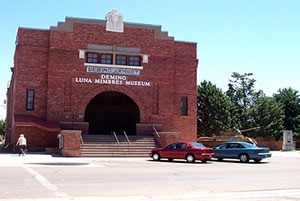
Welcome to the Deming Luna Mimbres Museum
You will find your visit here a delighful surprise. The goal of the museum is to depict the way people lived in Deming since its inception in 1881. Documenting the life of Deming citizens involves a striking diversity that defies traditional classification. You will just have to visit and see for yourself. Just to wet your appetite ...
History of the Deming Luna Mimbres Museum
The museum was founded to document the everyday lives of citizens of Deming and the Mimbres Valley. This unique charter has produced a vast range of exhibits that are sure to surprise visitors. The displays and exhibits range from antique office machines, to pottery displays containing artifacts. Many are over 1000 years old.
The charm of this museum is in its dedication to people's lives, not just history of buildings, wars, events, or specialty classifications. Perhaps the founders did not just want "His Story (history)"; they wanted "Everyone's Story". Here are just a few questions you may be able to answer after your visit:
- What did Main Street look like?
- What equipment did ranchers and farmers use?
- What was Deming's role in military history?
- What do telephone switchboards of the past look like?
- What was the culture of Deming in the early years?
- What toys did children enjoy?
- The Deming Luna Mimbres Museum was named for the City of Deming, Luna County, and the Mimbres Valley. It is housed in the old National Guard Armory which is located directly across the street from the Custom House and the Archives. Luna County Historical Society, a non-profit corporation, governs all three facilities.
|
1916 |
The building was built as a National Guard Armory and was used after Pancho Villa's raid on Columbus, New Mexico (30 miles south of Deming). It was the first Armory built after New Mexico became a state in 1912. In addition to military functions, the building was used for dances, basketball games, and a variety of social functions. |
|
WWI |
During WWI the building was used by the War Camp Community Service (forerunner of the USO). |
|
WWII |
During WWII, after the New Mexico National Guard was sent to phillpnines. The building was used as a USO to support soldiers training at Army and the Air Corp field in Deming. The building still bears the USO designation. After WWII it was again used as a Nat'l Guard Armory. |
|
1972 |
The museum was started in a small cottage. It was started by volunteers and after 30 years and is till operated and supported by volunteers, visitors, citizens of the area, gifts, and endowments. |
|
1977 |
The building was purchased from the State of New Mexico. |
|
1977 |
The museum moved to the Armory building. |
|
1978 |
The building was designated as a State Historic Site. |
|
1980 |
An endowment fund was established by Pauline and Hubert Ruebush and, as a result, the museum has grown through the generosity of members and friends of the Luna County Historical Society. |
|
1983 |
The building was placed on the National Register of Historic Places. |
- The museum continues to grow and since moving to this building, has had five major additions (art gallery, military room, ranching exhibit room, main street displays, and transportation room). In addition, the museum has acquired the Custom House and Archives which are located across the street.

Deming and adjacent area has had a long association with the military. There have been military establishments during the Apache wars, Mexican Punitive Expedtion, World War I and World War II
IMAGE: MilitaryRoom.jpg
Apache Wars - Fort Cummings (about 15 miles north of here) was established in 1862 by the California Column to secure a source of water for the Union west of the Rio Grande. Later the primary objective was to protect the immigrant route and the Butterfield stage line through Massacre Pass as well as the great spring at the entrance to the pass. The walled fort was active for almost 20 years and many artifacts were found there although the walls have largely melted back into the earth from which they came. A model of the fortr is also on display
.
Mexican Punitive Expedition - The Expedtion started from Camp Furlong which was 30 miles south of here. A number of artifacts relating to the march are on exhibit. Of special interst is a Maxim Machine Gun that was probably used by Gen. Carranza in pursuit of the Villistas. It is assumed that this was part of the German armament sent to Mexico to try to persuade them to keep the U.S. too busy to interfere in Europe.
World War I - A major training base (Camp Cody) was located at the northwest corner of the city. National Guard troops from Minnesota, the Dakotas, and Nebraska trained here prior to shipment to France. A number of uniforms and other equipment are shown in the wall cases as well as photographs of the camp.
World War II - A training base for the Air Corp bombardiers was located at the southeast corner of the city. Todays Municipal arifield was a portion of the base. A large drawing of the facility is exhinited as well as numerous artifacts including weapons, uniforms and Japanese and German equpiment. We should also note that near the entrance of main hall in the case to the right are a special tribute to the men of the national guard who were on the Bataan and in the U.S. during the wwar, approx 1%.
|
Main Street at Deming Luna Mimbres Museum
|
|
|
The store fronts along the Deming Luna Mimbres Museum Main Street exhibit represent early businesses in Deming.Each one is furnished and stocked with period items. Many have the original signs that hung on their hey-day. |
|
|
|
|
|
|
Parked along "Main Street" are antique vehicles including a Doctor's buggy and Deming's first car, a 1907 REO. At the end of the street, you will find an antique handoperated gas pump.
The stores are built to allow visitors to take a trip down memory lane or to learn about the past by just window shopping.
Mimbres Pottery

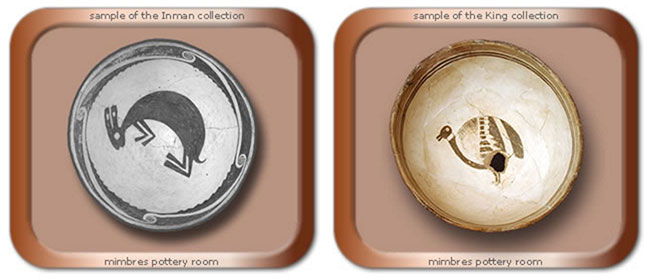
Thundereggs, Geodes and Nodules
|
|
A “tiltage egg” from Rockhound State Park (New Mexico) shows an angular unconformity in the “waterline” agate and opal layers caused by an ancient landslide that took place while the layers were emplaced. |
|
|
Sugar Bowl Mine Luna County, New Mexico |
|
|
A Baker Egg lithophysa withangel-wing-type plumes encrusted with quartz instead of chalcedony, as is the case with most such colloform growths. |
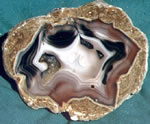 |
The contrasting colors in this agate filled lithophysa is typical for thundereggs from the Baker Egg mine. |
The Deming Luna Mimbres Museum proudly displays a world-class exhibit of Thundereggs, Geodes, and Nodules donated by Robert (Paul) Colburn of the Basin Range Volcanics Geolapidary Museum.. Rockhounds from all over enjoy this collection. Mr. Colburn has dedicated his life to the study of these geologic formations and is responsible for scientific redefinition of previously held “truths”.
Thunderegg is a Native American name for what Geologists call lithophysae or spherulites. Geode simply means an earth shaped hollow rock, or more specifically, a hollow Nodule with a crystal lined cavity.
When nodules are opened they may be simple or complex. While there is usually a “family resemblance” in Nodules and Geodes from a specific area, the best way to reveal the inner mystery is by opening the rock. You may become a Rockhound “wannabe” after seeing this incredible collection. You may have the sudden urge to become a detective unearthing (pun intended) the secrets of rock formation over centuries.
The specimens on display are the best from over 100 locations and were selected from tens of thousands of cuts made over 46 years of collecting. Each flawless specimen was chosen to typify the area where it was mined.
This collection provides a rare opportunity to view one-of-a-kind gifts of nature created over thousands of years. If your family or group includes a rock collector(rockhound), a future geology professor, or anyone who is marvels at the wonders that have been created in the millions years of earth formation, this is a sure hit for your visit
Source of Information and photography: The Formation of Thunder Eggs (Lithophysae) by Paul Colburn
More Background on the Deming Luna Mimbres Museum
Located in Deming, New Mexico, the Deming Luna Mimbres Museum is a vibrant cultural institution that showcases the rich history and diverse heritage of the region. Known affectionately as the "Smithsonian of the Southwest," this museum is renowned for its eclectic collection of artifacts and exhibits that reflect the everyday lives of the people of Deming and the Mimbres Valley. The museum's history, cultural significance, and community involvement make it a unique and fascinating destination for visitors from around the world.
History
The Deming Luna Mimbres Museum is housed in a historic building that was originally constructed as a National Guard Armory in 1916. This building was completed just two months after Pancho Villa's raid on nearby Columbus, New Mexico, and it played a significant role in the region's military history. Over the years, the building served various purposes, including as a USO during World War II. In 1977, the museum moved into this building, which was designated as a State Historic Site and later placed on the National Register of Historic Places in 1983.
Exhibits and Collections
The museum boasts an impressive array of exhibits that cater to a wide range of interests. Visitors can explore displays featuring Mimbres pottery, which is one of the museum's most prized collections. The Mimbres Indians, who lived in the region from about 950 to 1250 AD, are known for their intricate black-on-white and red-on-white pottery designs, often depicting animals and birds. These artifacts provide valuable insights into the lives and artistic traditions of the region's earliest inhabitants.
In addition to the pottery, the museum showcases a variety of other exhibits, including antique vehicles, period-furnished rooms, dolls, quilts, and war memorabilia. A notable exhibit is the collection of whiskey bottles in various shapes, reflecting the creativity and humor of past generations. The museum also features exhibits on the history of Deming, including its role in military conflicts and its early businesses, such as the first traffic light and a recreated Main Street with period shops.
Cultural and Social Significance
The Deming Luna Mimbres Museum holds significant cultural and social importance in the community. It serves as a testament to the region's diverse history and the resilience of its people. The museum's volunteer-driven model is particularly noteworthy, as it reflects the community's commitment to preserving its heritage. This volunteer-run approach has allowed the museum to thrive despite limited resources, making it a model for community-based museums.
The museum's diverse collection ensures that there is something for everyone, appealing to a broad audience. It is often praised for its inclusive nature, welcoming visitors from all walks of life. The museum's role in educating visitors about the region's history and cultural practices is invaluable, fostering a sense of community and shared identity among locals and visitors alike.
Press and Media Coverage
The Deming Luna Mimbres Museum has received positive press and media coverage over the years. It is frequently described as a hidden gem, offering a unique experience that sets it apart from larger, more formal museums. The museum's eclectic collection and warm atmosphere have earned it comparisons to the Smithsonian Institution, with many referring to it as the "little Smithsonian" of the Southwest.
Dr. Jerry Brody, a retired professor of anthropology, has praised the museum for its ability to thrive despite being volunteer-run and low-budget. He notes that the museum's success is a testament to the dedication of its community and the importance of preserving local history.
John Porter Bloom, a former historian with the National Park Service, has also commended the museum, stating that it is "head and shoulders above anything in any town of its size anywhere in the United States."
Audience and Reviews
The Deming Luna Mimbres Museum attracts a diverse audience, including tourists, locals, and snowbirds who visit during the winter months. Visitors often comment on the museum's ability to cater to a wide range of interests, ensuring that everyone finds something fascinating. The museum's welcoming atmosphere and the variety of exhibits make it a must-visit destination for anyone interested in history, culture, or simply exploring the unique character of Deming and the Mimbres Valley.
Reviews highlight the museum's charm and the sense of community that pervades it. Visitors appreciate the opportunity to learn about the region's history in a setting that feels more like a family home than a formal museum. The museum's volunteer staff are often praised for their knowledge and enthusiasm, adding to the overall warmth and inclusiveness of the experience.
Known For
The Deming Luna Mimbres Museum is known for several key aspects:
-
Mimbres Pottery Collection: The museum houses one of the largest and most impressive collections of Mimbres pottery, showcasing the artistic achievements of the region's earliest inhabitants.
-
Eclectic Exhibits: From antique vehicles to whiskey bottles, the museum offers a diverse range of exhibits that cater to various interests.
-
Community Involvement: The museum is entirely volunteer-run, reflecting the community's commitment to preserving its heritage.
-
Historic Building: The museum is located in a historic building that has played a significant role in the region's military and social history.
Details and Insights
One of the museum's most compelling aspects is its ability to balance historical significance with a sense of community and inclusiveness. The exhibits are not just artifacts on display; they are stories about people's lives, reflecting the diversity and resilience of the region. The museum's focus on everyday life rather than grand historical events makes it relatable and engaging for visitors.
The museum's collection of Mimbres pottery is particularly noteworthy. These artifacts not only demonstrate the artistic skill of the Mimbres Indians but also provide insights into their daily lives and cultural practices. The use of natural materials like yucca leaves to create brushes for painting pottery highlights the resourcefulness and creativity of these early inhabitants.
Examples and Specifics
A visit to the Deming Luna Mimbres Museum offers a unique opportunity to explore the region's history through tangible artifacts and immersive exhibits. For example, the recreated Main Street allows visitors to step into the past, viewing period shops and businesses that once thrived in Deming. The presence of antique vehicles, including Deming's first car, a 1907 REO, adds to the sense of nostalgia and historical depth.
The museum's collection of geodes and thundereggs, donated by Robert Colburn, is another highlight. These geological formations offer a glimpse into the natural wonders of the region, showcasing the beauty and complexity of the earth's creations.
The Deming Luna Mimbres Museum is a cultural treasure that embodies the spirit of community and historical preservation. Its diverse exhibits, volunteer-driven model, and inclusive atmosphere make it a standout destination in the Southwest. Whether visitors are interested in history, culture, or simply exploring the unique character of Deming and the Mimbres Valley, the museum offers something for everyone. Its significance extends beyond its collections, serving as a testament to the power of community engagement and the importance of preserving local heritage.
